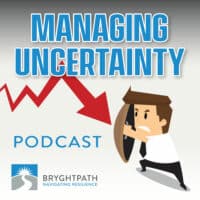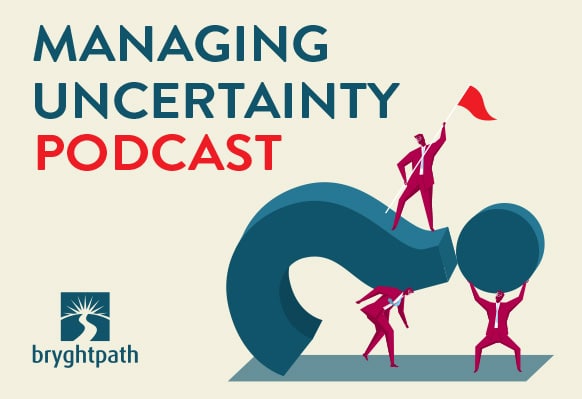
In this episode of the Managing Uncertainty Podcast, Bryghtpath Principal & CEO Bryan Strawser talks about threat incident risk factors in threats of workplace violence, including potential suicide situations. Topics discussed include threats of suicide, threat management, workplace violence prevention, and domestic violence.
Related Articles & Blog Posts
- Episode #30: Threat Management in Educational Institutions
- Episode #42: Threat Severity Levels
- Episode #43: Threat Management Framework
- Bryghtpath’s Managing Threats Workshop
- Association of Threat Assessment Professionals
Episode Transcript
Hey Folks, Bryan Strawser, Principal and CEO at Bryghtpath, and welcome to the Managing Uncertainty podcast for this week where we’re going to be talking about threat incident risk factors.
When we think about threat management, and threat management programs, one of the ways that we evaluate the risk of a threat, and I’m talking about a threat from an individual, a threat in terms of workplace violence, or against an individual in your company like an executive, or others. When we think about a set of threat incident risk factors, these are things that go along with threats such as written, verbal, or veiled threats made towards your company, at your company, in regards to your company, or an individual working there that might be a precursor to violence.
These are important things to consider when we’re thinking about how serious to take a threatening situation, with comments or commentary made by an employee or others. Let’s walk through some of these risk factors, and we divide these into four categories. The first is about threat incident risk factors that indicate potentially a desire to commit suicide.
The first is that the individual has had previous attempts to take their own life. No matter how serious or insignificant they may be. Previous attempts to commit suicide. The second is to look at their level of alcohol or substance abuse, drug abuse, particularly if any of those are prevalent. The third is a feeling of hopelessness that the individual exhibits what can be viewed as signs of depression, signs that there are no hope, that there’s no way out of a difficult situation or relationship, or debt, or another factor in their life.
The fourth is impulsiveness, that the individual is an impulsive decision maker, that they make impulsive decisions in the course of their life. They suddenly decide on a Friday to go to Cancun on Saturday. They jump into a relationship, and instantly plan to get married. These kind of impulsive decisions. They go out an rapidly buy a new car after just commenting about debt.
Another high risk factor for suicide is a recent significant loss. This could be employment, or a job. It could be a financial situation. It could be a relationship or a marriage, or a close friendship that has ended, but have they have a recent significant loss?
The next factor and perhaps one of the most important factors when it comes to gaging the risk of suicide with an individual is access to lethal means. Do they have the means available to them, easily available to them, that would allow them to take their own life? This could be ownership of a firearm. It could be talking about knives, or suicide via gas, or different ways that are out there that an individual might use, and that they have access to.
The next is another significant risk factor, and that is creation or verbalization of a plan, or perhaps a written plan or ideas that they have shared, and a post on Facebook, or other social media in writing, in their diary that they talk about, but individuals who have made a plan, and who have access to lethal means are at high risk of suicide, high risk of taking their own life.
The next risk factor is lack of social support, that they don’t have friends and family, and others to lean on that are nearby. They don’t have a close social network that serve as anchors to help them through a difficult situation. The next risk factor is withdraw, and here we think about withdraw from work, from relationships, from activities that they used to enjoy, and then lastly, a decline in their performance at work or in school, or in other things that they do.
These are all threat incident risk factors that we would evaluate that we see as a precursor to a suicide. The two most important, again, are access to lethal means, and the creation or verbalization of a plan. There are also a number of factors related to threats of domestic violence that we would talk about in a situation where domestic violence might be present. The first is the presence of weapons, firearms and knives being the most common, but blunt instruments are another, and of course there’s many things around one’s home that could be used as a weapon, but we’re really kinda focused on firearms and knives being present as a risk factor for domestic violence.
The second is seeing harassing communications, phone calls, emails, text messages, notes, mail, are rarer now as communication has evolved, but still show up in these cases. The third risk factor is recent breakup or recent loss of the relationship is a triggering factor for domestic violence. The fourth is an increase in behavior, and an increase in frequency around harassment, emotional and verbal harassment in particular. Then there’s the obvious signs of physical violence that the individual has a record. They have previously, physically abused an individual, or they have previous physical violence record or accusations in the past, whether proven or not.
The next risk factor is substance abuse, again, this is both alcohol, and other drugs that could be a risk factor for domestic violence. The impulsivity or impulsiveness of the individual is also at play, and then lastly, there’s previous record of violating orders for protection, or a restraining order as it’s called in some jurisdictions.
These are all risk factors for domestic violence that could be used as you’re evaluating the risk of a threat of domestic violence from an individual. Usually you’ll find this is directed at an employee or contractor at your organization, and you’re evaluating this as the security manager, HR business leader, trying to understand what’s the actual risk of this occurring.
The third category of risk factors that we look at for threats are employee on employee violence, or if you’re in an education organization, you also have to look at student on student violence, or some combination thereof, employee on student, student on employee, third part on employee, third party on student, and vice versa, so again the first is the presence of weapons, again, firearms and knives being the two most prevalent that we’re concerned about.
The second is that there has been a direct and actionable threat made. Now direct and actionable means that the threat is specific, actionable in that it contains enough details that you can understand the mechanism by which they intend to hurt the individual. This is very similar to what we talk about with suicide in terms of the laying out a specific plan and verbalizing that plan. There’s a big difference in saying, “I’m gonna kick his ass,” and interpreting that as a threat, which to some extent that it is, but a much more serious threat would be “I’m going to ambush him when he comes out of work tomorrow, and I’m gonna stomp his ass in the parking lot.”
Well, that’s a very different level of specificity, very different level of the plan then just saying “Hey, I’m gonna kick this person’s ass,” so the direct threat. Particularly if that threat is directly made to the individual being threatened, is a much stronger likelihood that something could happen.
The third risk factor is a history of violence when you’re looking at the individual making the threats, so they have a tract record of making threats, and carrying out those threats with violent action previously. The fourth is a perception of injustice or perceived injustice from the threatening individual that they feel like they’ve been harmed or wronged by the individual they’re making the threats at, or by your institution or organization. The next risk factor is hostile or aggressive attitude. This is where an individual’s outlook and general demeanor is hostile and aggressive, is also a strong risk factor for violence.
If the individual making the threats is bullying or is the victim of bullying, so they’re a bully, or they have been the victim of bullying, also increases the risk. Other risk factors are similar to those we’ve discussed before, a record of physical violence or speaks directly about physical violence, history of alcohol and substance abuse, problems with employment or as a student, or a decline in performance as a student, or employee or contractor, and then lastly just escalation of aggression, meaning that in the various interactions between the individual making the threats, and person being threatened or the organization being threatened, that we see an escalation in the level of aggression coming from that individual, and then finally when we look at threats being made by an outside subject, a third party who is threatening your organization or someone in the organization there’s a number of risk factors that we want to examine, and these are similar to others we’ve looked at before.
Again, we start with the presence or access to weapons, particularly firearms and knives, second are they making direct threats? As we’ve talked about before, are they making specific actionable threatening comments towards the organization, and are they doing this in a repeated way? Are there repeated threats being made? What’s the history of violence of the individual making threats? Are we aware of their previous criminal activity, if any? Do they have a record of physical violence in previous incidents, or in their past? Have they a record of alcohol or substance abuse that might be at play here, and then finally do they show a lack of respect or restraint in their approach towards the organization.
We list all of these as risk factors. These are all things that should be evaluated as a part of a robust threat management program when you’re dealing with a threat, and evaluated properly in that threat management discussion to determine how much risk there is from this particular example. If you like an easy one page version of this list of risk factors, that you can use of your own threat management program, visit bryghtpath.com/41, and you’ll be able to download our one page table of threat incident risk factors.
That’s it for this episode of the managing uncertainty podcast. Tune in next week for our next episode.

